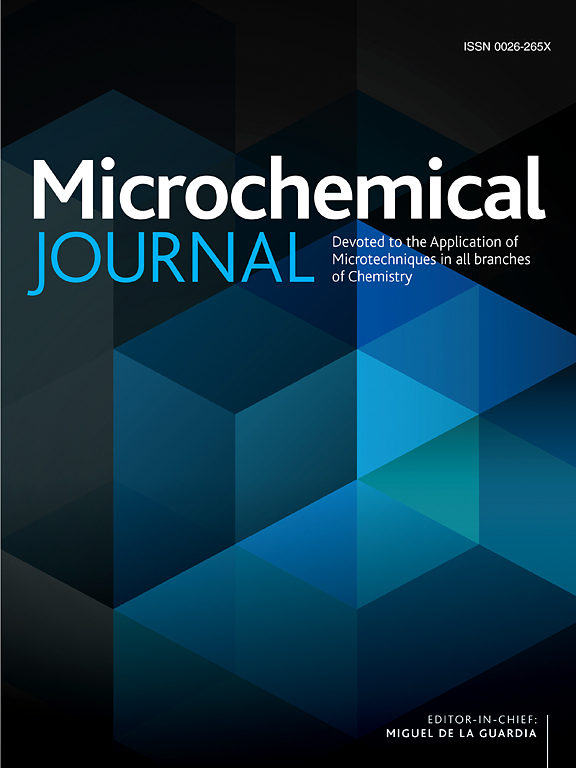基于二维层状双氢氧化物和外切酶 I 的用于 DNA 和 microRNA 检测的荧光传感平台
IF 4.9
2区 化学
Q1 CHEMISTRY, ANALYTICAL
引用次数: 0
摘要
层状双氢氧化物(LDHs)与核酸之间的界面和层间相互作用为 LDHs 吸收和检测核酸提供了巨大的潜力。在此,我们展示了一种基于二维 LDHs 和外切酶 I(Exo I)的简单、快速、多功能荧光传感平台,用于选择性分析 DNA 和 microRNA。ZnNiAl-LDHs 被用作单链 DNA(ssDNA)探针上 FAM 标记的淬灭剂,通过高荧光淬灭能力进行动态淬灭。通过光谱分析、表征实验、DNA 吸附和解吸研究、zeta 电位分析和分子动力学模拟,对淬灭机制进行了探索。首次证实了 LDHs 对荧光团标记核酸的吸附驱动力是静电作用、范德华力和阴离子交换。为了从 FAM-ssDNA 探针中区分已形成的目标/探针双链体,引入了 Exo I 来特异性水解 FAM-ssDNA 探针。所制作的核酸检测荧光传感平台的检测限低至 0.08 nM。最后,该传感器被有效地用于检测实际生物和环境样品中的 DNA 和 microRNA,回收率从 96.4 % 到 105 % 不等,表明其准确性很高。这项工作为序列特异性核酸检测提出了一个前景广阔的传感平台,并为二维 LDHs 作为生物医学应用的结构支撑和生物分子库提供了一个新的视角。本文章由计算机程序翻译,如有差异,请以英文原文为准。

Fluorescent sensing platform based on two-dimensional layered double hydroxides and exonuclease I for DNA and microRNA detection
Interfacial and interlayer interactions between layered double hydroxides (LDHs) and nucleic acids offer LDHs great potential to absorb and detect nucleic acids. Herein, we demonstrate a simple, rapid, and versatile fluorescent sensing platform based on two-dimensional LDHs and exonuclease I (Exo I) for the selective analysis of DNA and microRNA. ZnNiAl-LDHs were utilized as quenchers for FAM labelled on single-stranded DNA (ssDNA) probes via dynamic quenching with high fluorescence quenching ability. The quenching mechanism was explored by means of spectral analysis, characterization experiments, DNA adsorption and desorption studies, zeta potential analysis, and molecular dynamics simulations. The driving forces for the adsorption of LDHs toward fluorophore-labelled nucleic acids were confirmed to be electrostatic interaction, van der Waals force, and anion exchange for the first time. In order to distinguish the formed target/probe duplexes from FAM-ssDNA probes, Exo I was introduced to specifically hydrolyze FAM-ssDNA probes. The fabricated fluorescent sensing platform for nucleic acids detection shows a low detection limit of 0.08 nM. Finally, this sensor was effectively utilized for the detection of DNA and microRNA in actual biological and environmental samples, achieving recoveries ranging from 96.4 % to 105 %, indicating high accuracy. This work proposed a promising sensing platform for sequence-specific nucleic acids detection, and provides a new perspective on two-dimensional LDHs as structural supports and biomolecular reservoirs for biomedical applications.
求助全文
通过发布文献求助,成功后即可免费获取论文全文。
去求助
来源期刊

Microchemical Journal
化学-分析化学
CiteScore
8.70
自引率
8.30%
发文量
1131
审稿时长
1.9 months
期刊介绍:
The Microchemical Journal is a peer reviewed journal devoted to all aspects and phases of analytical chemistry and chemical analysis. The Microchemical Journal publishes articles which are at the forefront of modern analytical chemistry and cover innovations in the techniques to the finest possible limits. This includes fundamental aspects, instrumentation, new developments, innovative and novel methods and applications including environmental and clinical field.
Traditional classical analytical methods such as spectrophotometry and titrimetry as well as established instrumentation methods such as flame and graphite furnace atomic absorption spectrometry, gas chromatography, and modified glassy or carbon electrode electrochemical methods will be considered, provided they show significant improvements and novelty compared to the established methods.
 求助内容:
求助内容: 应助结果提醒方式:
应助结果提醒方式:


